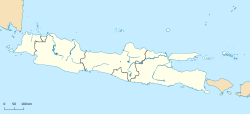| Candi Kethek Pyramid Hindu temple | |
|---|---|
 Candi Kethek's pyramid shaped terraces | |
| Location | Mount Lawu, Jenawi district, f Karanganyar Regency, Central Java, Indonesia. |
| Coordinates | 7°35′39″S111°9′28″E / 7.59417°S 111.15778°E |
| Built | Built by Mataram kingdom 15th-16th century |
Candi Kethek is a terraced megalithic pyramid-shaped 15th-16th century Hindu temple on the northwest slope of Mount Lawu in Anggrasmanis village of Gumeng subdistrict in Jenawi district of Karanganyar Regency in Central Java of Indonesia. [1] [2] The temple has seven terraces facing west, each terrace is connected by stone steps. [3] There is an alternative path to the top terrace on the south side. Kethek Temple is located northeast of the fifteenth-century Javanese-Hindu Ceto Temple. To reach Candi Kethek, visitors must take a 300 m footpath from Ceto Temple in the direction of the path leading to Puri Taman Saraswati.


